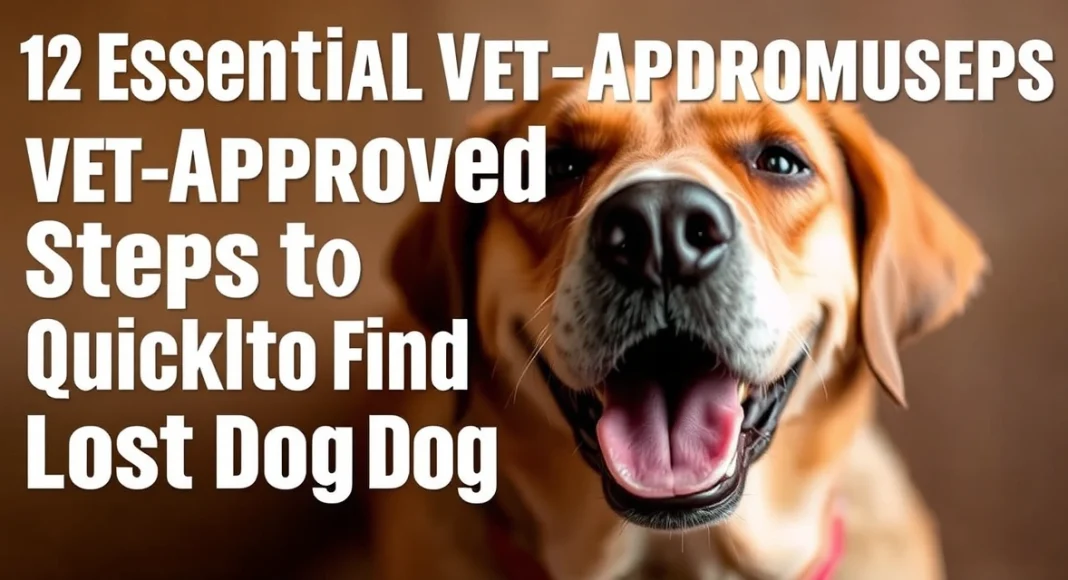12 Essential Vet-Approved Steps to Quickly Find Your Lost Dog
Every pet owner prioritizes the safety, health, and happiness of their furry companions. However, despite our best efforts, there may come a time when our beloved pets go missing. The moment you realize your dog is lost can be terrifying and overwhelming. It is crucial to act quickly and efficiently to increase the chances of a successful recovery. In this article, we will outline the 12 essential vet-approved steps you can take to find your lost dog, ensuring you have a comprehensive plan to guide you through this distressing situation.

When a dog goes missing, every second counts. The longer you wait to start your search, the farther your dog may wander. By following these vet-approved methods, you can improve your chances of a swift and safe reunion with your pet. From utilizing technology to leveraging your community, these strategies will empower you to take immediate action and mobilize resources effectively. Let’s dive into the essential steps for lost dog recovery!
1. Stay Calm and Assess the Situation
In the frantic moments after realizing your dog is missing, it’s vital to remain calm. Panicking can cloud your judgment and hinder your ability to think clearly. Take a moment to gather your thoughts and assess the situation:
- Determine when and where you last saw your dog.
- Understand your dog’s behavior—are they likely to run far or stay close?
- Identify any potential escape routes they might have taken.
2. Search Your Immediate Area
Your first action should be to conduct a thorough search of your home and yard. Dogs often hide in familiar places when frightened. Follow these tips:
Check Inside Your Home
Look in every room, including closets, under beds, and behind furniture. Sometimes dogs find cozy spots to curl up in when they feel anxious.
Explore Your Yard
If you have a yard, check all corners, bushes, and any places where your dog might be hiding. Call your dog’s name in a calm and reassuring tone to encourage them to come out.
3. Expand Your Search to the Neighborhood
If your initial search doesn’t yield results, it’s time to expand your search. Head out into your neighborhood, taking your dog’s favorite treats or toys to attract them.
- Walk the streets where you last saw your dog.
- Knock on doors and speak to your neighbors, asking if they’ve seen your pet.
- Check parks, playgrounds, and any nearby open spaces.
4. Use Technology to Your Advantage
In today’s digital age, leveraging technology can significantly aid in your search for a lost dog. Here are some tech-savvy methods to consider:
Social Media
Post about your lost dog on local community groups, neighborhood apps like Nextdoor, and your personal social media accounts. Include a clear photo and a description of your dog, along with your contact information.
Lost Pet Websites
Utilize online databases like PetAmberAlert, PawBoost, or local animal shelters’ websites to report your lost pet. These platforms often have extensive networks and can help spread the word quickly.
5. Create Eye-Catching Flyers
Physical flyers can be effective in your search. Create clear, colorful flyers with your dog’s photo, description, and your contact information. Distribute them in your neighborhood, local parks, vet clinics, and pet stores.
Tips for Designing Effective Flyers
- Use bold, readable fonts and bright colors.
- Include a reward for information leading to your dog’s recovery.
- Consider adding a QR code that links to your social media post or lost pet page.
6. Involve Animal Control and Local Shelters
Contact local animal control agencies and shelters to report your lost dog. Provide them with your dog’s description and your contact information. Check back frequently to see if your dog has been brought in.
Visit Shelters in Person
While calling is important, visiting shelters in person can be more effective. Many shelters have numerous animals coming through their doors, and being physically present increases your chances of finding your dog.
7. Use Scent to Attract Your Dog
Dogs have a remarkable sense of smell. Leaving familiar scents in your yard or around the area where your dog was last seen can help guide them back home. Here are some ideas:
- Leave out your dog’s bedding or favorite toys.
- Put out some of your worn clothing to provide a comforting scent.
8. Set Up a Safe Space
Consider setting up a safe space in your yard where your dog can feel comfortable returning. Create a cozy area with food, water, and familiar items. Leave the gate open so they can come and go freely.
9. Keep an Eye on Your Surroundings
As you continue your search, pay attention to your surroundings. Look for any signs of your dog, such as:
- Dog tracks or paw prints.
- Food or water bowls that seem disturbed.
- Other pets that may indicate your dog’s presence.
10. Utilize Local Pet Search Groups
Join local lost pet groups on social media platforms or community websites. These groups can provide support and additional resources for finding lost pets.
Engage with Local Volunteers
Many communities have dedicated volunteers who assist in searching for lost pets. Reach out to them for help or even organize search parties.
11. Stay Persistent and Motivated
Finding a lost dog can be a lengthy process. Stay motivated and persistent in your search. Regularly update your flyers and social media posts with any new information or sightings.
12. Consider Professional Help
If you’ve exhausted all avenues without success, consider hiring a professional pet recovery service. These experts have specialized training and resources to help locate missing pets effectively.
Important Points to Remember
- Stay calm and think clearly during your search.
- Utilize technology and community resources effectively.
- Leave familiar scents to help guide your dog home.
- Engage with local shelters and animal control for support.
- Be persistent and keep your spirits high throughout the process.
Frequently Asked Questions (FAQ)
1. What should I do first if my dog goes missing?
The first step is to stay calm and conduct a thorough search of your home and yard before expanding to the neighborhood.
2. How can I use social media to help find my lost dog?
Post clear photos and descriptions of your lost dog on local community groups and your social media accounts to reach a wider audience.
3. Should I offer a reward for finding my dog?
Offering a reward can incentivize people to help look for your dog, but ensure it’s clearly stated in your flyers and online posts.
4. How long should I continue the search for my lost dog?
Continue your search until you have exhausted all options and resources. Dogs can sometimes return home days or even weeks after going missing.
5. Are there professional services that can help find my lost dog?
Yes, there are professional pet recovery services that specialize in finding lost pets and can provide valuable assistance.
Conclusion
Having a dog go missing can be one of the most distressing experiences a pet owner can face. However, by following these 12 essential vet-approved steps for lost dog recovery, you can enhance your chances of a successful reunion with your beloved pet. Remember to stay calm, use technology, and engage your community to mobilize support. With persistence and the right strategies, you can bring your furry friend home safely.
📰 Original Source
Este artigo foi baseado em informações de: https://www.dogster.com/lifestyle/how-to-find-a-lost-dog-updated




